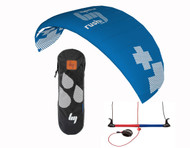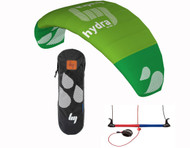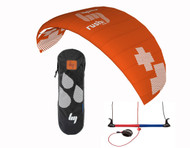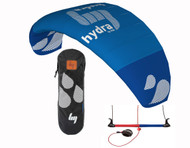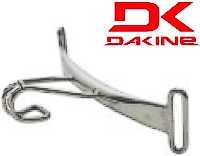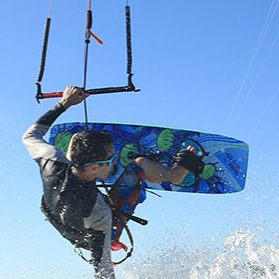
I'm new! I'm looking for a trainer kite...
I'm looking for a beginner, entry-level power kite for...
I'm looking for a board...
- Home
- Kiteboard
- Learning Center
- Types of Kite Harnesses
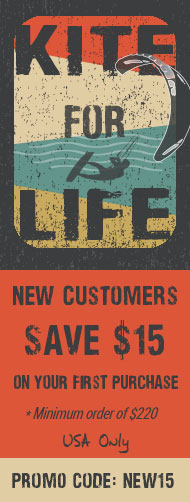
Categories
Brands
Current Top Sellers
-
$279.00

-
$389.99$379.99
-
$349.99

-
$439.99$435.45
-
$348.50$345.50
Types of Kite Harnesses

Understanding How a Harness Works
A harness is used for:
- Transferring the pull of the kite (load on your arms) to your body.
- Creating a center balance point, allowing you to steer with one hand.
A harness functions using 3 parts: Harness, hook, and loop.
- Harness: Seat or waist style. Heavy duty padded nylon with straps.
- Hook: Attached to the front of the harness.
- Loop: Depending on the kite design, can be a "harness-line" or "chicken-loop"
Trainer Kites and Standard Foil Kites use a Harness-line (also know as a Fixed Loop).
Inflatable Kites (Kahoona), and Sheetable Foils (Apex, Montana, Matrixx ) use a Chicken-Loop (also called a Trim-Loop ).
Image: Diogo Dantas learning to use a waist harness with a stainless-steel harness-hook
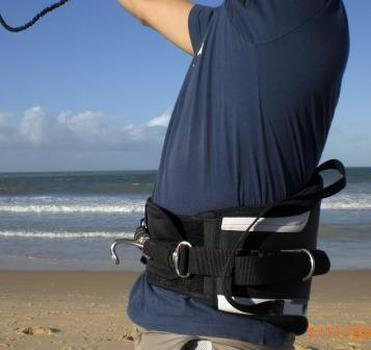
Notice that a waist harness only goes around the waist. (no leg-straps)
Harness-Hook (aka Spreader-Bar)
Older windsurfing harness hooks were aluminum. When kiting, we ONLY use hooks made from "stainless steel"
The harness-hook is open, similar to the shape of a coat-hanger. Harness hooks are also called "Spreader Bars" because the wide base of the hook spreads-out the load.
Kite Control-Bar with Quick-Release Harness-LINE (also called a "Fixed Loop") This loop is attached to the outside of the Bar and has a fixed-length. Fixed-Loops are the norm for Standard fixed-bridal Foil Kites. (Ex: Rush, Hydra, & Scouts).
The Harness-line is a "U" shaped loop.
Look closely at the upper-right end of the white loop. You can see the a small Safety "Quick-Release" ( smaller o the 2 red-balls) used to open the loop in an emergency. The larger red ball near the center of the loop is the "3rd-Line Kite Safety-Leash.
Look carefully at the loop on this bar. Scroll up and look again at the image directly above.
See the difference? This Chicken-Loop (aka Depower-loop) is floating below the bar. It's Not fixed. The center line (aka Depower-line) passes through a hole in the bar, allowing the bar to slide further or closer to the loop as you "Sheet-out" or "Sheet-in".

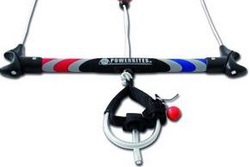
The small vertical "chicken-stick" (aka donkey-dick) pointing downward at the bottom of the loop, is used to "lock the loop" onto your spreader-bar.
"Hooked-in" is the term used when the loop is connected to your hook.
A moment after this photo was shot, the instructor
said.. "Now, "Un-hook". while keeping your kite steady.
As a beginner, you will initially need to watch the kite as you're "unhooking" and only glance down at your hook.
Harness Steps
First: Be sure to master the basic kiting-skills withOUT using the harness.
Next, practice hooking-in for just a second, and then un-hooking.
Hook-in > Un-hook > Hook-in > Un-hook > Repeat.
You'll want to practice getting in and out of the loop over and over until you can do-it without looking at it directly. (Ok to use your peripheral vision). Always be aware of your kites position and movement.
Selecting a Harness
Note: ALL Harnesses and Harness-Hooks will work perfectly with ALL types of Kites and bar, and Loops. Complete Compatibility. The only decision is selecting a harness type that YOU are comfortable with... Seat vs Waist.
2 Types of Harnesses: Seat and Waist
There are 2 basics basic styles/ types of harnesses used for kiting: The waist harness and the seat harness. Below are the pros and cons of each harness type.
 Waist Harness
Waist Harness
- No leg straps
- More freedom of movement
- Tendency to Side-up/ Ride-up out of position, moving off your waist and up closer to your ribs.
Seat Harness 
- Sits lower on your body.
- Leg straps hold the harness in its intended position, preventing "Ride-up"
- Generally offers more low-back support
- Popular with snow-kiters
Which is better... Waist or Seat?
It's simply a matter of preference. A better question is "Which type is best for me?"
- Snow-kiters "tend" to prefer the seat design.
- Wave-riders and free-stylers generally prefer the waist harness.
- People with a wide middle ( aka body by Budweiser ) tend to prefer a seat-harness.
- People with athletic builds tend to prefer the waist design.
Notice the words "prefer" and "tend", meaning that all types of kiters can be found using each type of harness. It's a personal preference.
Harness Brands, Models, Size Chart and Prices
The price of harnesses ranges from $170 (Dakine Chameleon) up to $350 (Mystic Code01). If you see any listed for less, be sure to check if it includes the needed Stainless-Steel Spreader Bar. Some shops price their harnesses separate from the spreader bar. Look carefully before you pay. Many models also include a Bar-Pad (for added comfort) and a safety-hook-knife.
There are many harness Brands: Best, Dakine, HQ, Mystic, Prolimit. just to name a few.
This is HQ's Waist Harness. Notice the integrated Bar-Pad. (extra padding surrounding the Spreader-Bar).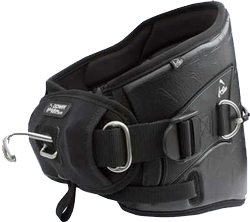
Just below the Bar, you can see a nylon-loop which is the grab handle for the included Hook-Knife. Many harnesses have their knife in the back where it's difficult to reach.The front, below the bar location for the knife is brilliant. The D-shaped steel rings on each side and the line running between the 2 rings,are places designed for connecting your Kite-Leash.
Sizing
Just like clothing, sizing varies a bit between brands and models. If you have the opportunity to try on a harness locally.. do it! I personally love shopping online for most things, but for getting the ideal fit and max comfort, items such as harnesses, helmets, and personal apparel are best bought at a local shop.
XS 28-30
S 30-32
M 32-34
L 34-36
XL 36-38
XXL 38-42+
Do you need a harness?
- If flying a trainer or another small kite... No. A harness is not a necessity.
- Actually, you'll want to first master the basic kite-skills before using a harness.
- If flying a larger kite, an inflatable, or sheetable foil, then Yes.. you will need a harness.
Kite Safety Leashes
- Trainer-Kites are normally sold complete with the Kite, Bar and lines, and Safety-Kite-Leash.
- Control bars w/ lines for inflatable kites also normally include a kite-leash.
- Some kites do NOT include a kite-leash. Always a good idea to ask what's included.
The Leash below is designed for larger more powerful kites. It includes 2 quick clips and an adjustable release mechanism. Most leashes have a quick-release, but few have an adjustable release like the one above.
Shown: HQ Leash # 119423 List Price: $47.
- This leash is typical of what's included with most Trainer-Kites. No metal quick clips.
- The leash comes pre-attached to the 3rd-line at one end, and the other end has a velcro-cuff for your wrist.
- The leash is much thinner and lighter than the image above because it's used with small less powerful kites.
- If you end up getting a harness to use with your Trainer-Kite, be sure you have the needed harness-line ( fixed loop).
- Details on the loop at the top of this page.
 Loading... Please wait...
Loading... Please wait...



